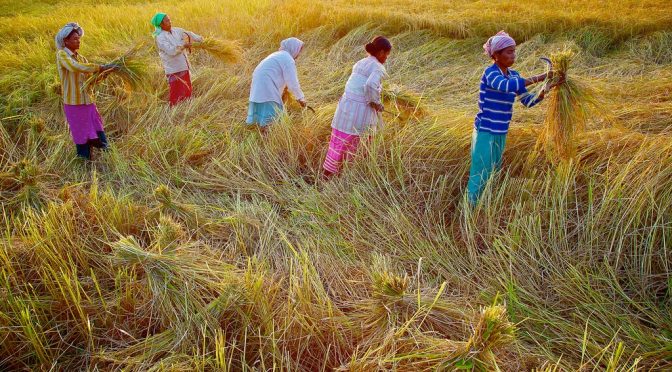
By Ganesh Bhatt
Revolution
Revolution is defined as a dramatic and wide-reaching change in conditions, attitudes, or operation, a forcible overthrow of a government or social order, in favour of a new system, a drastic change in a field such as industry or technology, or similarly, a sudden, often violent uprising from the people to change the political system.
This …
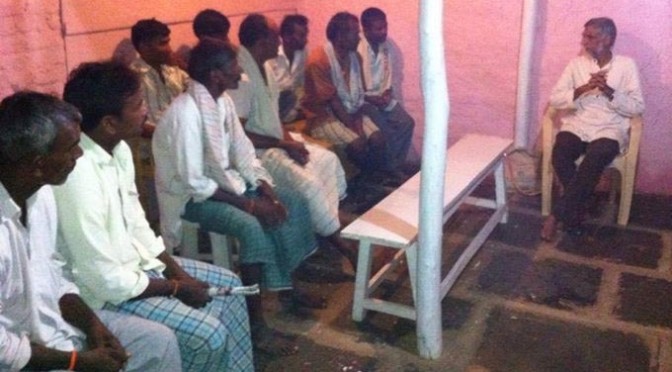
Picture above: Kannada samaj leader Ghanesh Bhat (right) at a farmers meeting at Allapur, Hubli in Karnataka, India.
The Kannada samaj-movement of Karnataka, India, focusses on generating awareness among farmers about giving industrial status to agriculture. Kannada representatives are conducting meetings in villages and interacting with farmers.
“Though there are hundreds of problems faced by farmers, we are focusing on …
(New Delhi, June 22, 2014) – “‘The length of National Highways in the country is one lakh [100.000] kilometre. I have asked officials to come out with a plan to plant 200 crore [2.000.000.000] trees along these stretches which in turn would create jobs for the unemployed on the one hand and protect the environment on the other,’ Road Transport, …
By P.R. Sarkar
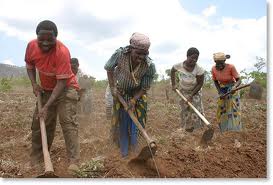 (February 1982, Calcutta) – Providing food, clothing, housing, education and medical treatment is most important for social security. These five minimum requirements are indispensable to raise the living standard of the people. To guarantee these, the principle of production based on consumption has to be adopted. Special emphasis should be placed on agricultural production because the provision …
(February 1982, Calcutta) – Providing food, clothing, housing, education and medical treatment is most important for social security. These five minimum requirements are indispensable to raise the living standard of the people. To guarantee these, the principle of production based on consumption has to be adopted. Special emphasis should be placed on agricultural production because the provision …
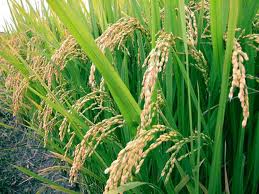 By P.R. Sarkar
By P.R. Sarkar
The economic development of a country depends on the collective labour of different social groups. This is the reason that the system of the division of labour gradually evolves out of the practice of domestic economy. The value of the labour of all groups, including industrial labourers, peasants, carpenters, blacksmiths, goldsmiths, potters, physicians and clerks, is equal …
By Ravi Logan
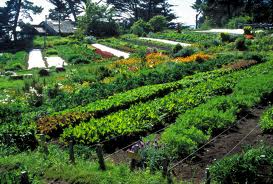 Like permaculture, PROUT is a solution-oriented approach to creating sustainability by applying design principles that model the way nature works. The difference between the two approaches is in the realm of application of their respective sets of design principles.
Like permaculture, PROUT is a solution-oriented approach to creating sustainability by applying design principles that model the way nature works. The difference between the two approaches is in the realm of application of their respective sets of design principles.
Permaculture design principles were developed as a method to guide sustainable resource management (though much has been done …
Socialization
By P.R. Sarkar
In all human actions the tender touch of humanity should be present. Those with the tendency to not deprive others cannot, on the grounds of justice and equity, accept the principle of private ownership. The economic structures in the world today, however, are not based on human rights. In order to recognize human rights, one will …
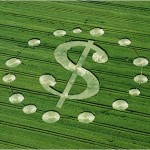 P.R. Sarkar
P.R. Sarkar
Should development schemes for the all-round elevation of an agricultural country or region and an industrial country or region be the same in theory or different from each other?
Development in the sense of all-round elevation is the summum bonum of economic activity. That is, development means integrated, compact and multi-purpose development.
Principles and theories remain unchanged although …
 P.R. Sarkar
P.R. Sarkar
Our system of integrated farming is designed to utilize every inch of land. Not only should the surface land be fully utilized, but the space under the surface, and even the space above the surface, should be used to the maximum. The surface, the sub- surface and the space above the surface is to be used 100%.
There …
 Q. What should be the percentage of population supporting themselves on agriculture?
Q. What should be the percentage of population supporting themselves on agriculture?
In a developed economy only 30 to 45% of the population should support themselves on agriculture. In countries where a greater population live on agriculture there should be an endeavour to shift the surplus population to agro-based and agrico-(post-harvest) industries.
Q. What will the mode of development of …
For the good and happiness of all








